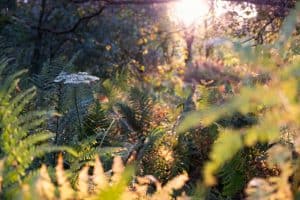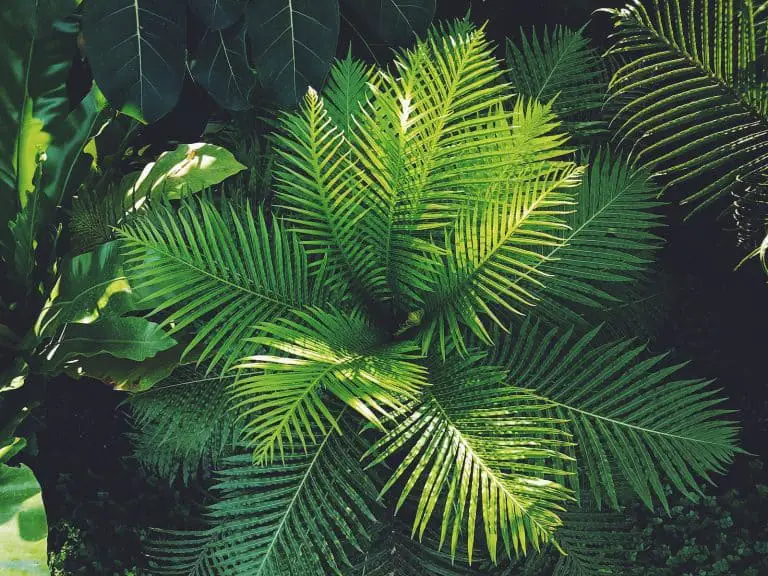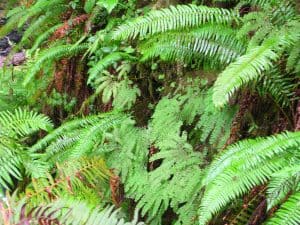Looking to add a touch of green elegance to those shady spots in your garden? Ferns for shade gardens are your go-to plants, with their lush foliage and diverse forms. They’re not just beautiful; they’re also champions of the understory, thriving where other plants might struggle.
From the vibrant autumnal hues of some woodland ferns to the delicate fronds of maidenhair varieties, there’s a fern to suit every shaded corner. And don’t worry about those dry, shady areas; many ferns are surprisingly drought-tolerant once established. Let’s explore the best ferns to transform your shaded garden spaces into a serene green retreat.
Benefits of Ferns in Shade Gardens

Transforming Shady Spaces with Ferns
Ferns for shade gardens are a brilliant choice for bringing life to underutilized, shady areas in your yard. Shade-loving ferns, like the elegant Japanese Painted fern or the lush Lady fern, are known for their ability to thrive without direct sunlight. Their light green fronds can brighten a dim garden corner, providing a rich backdrop for flowering perennials or acting as striking companions to hostas.
Shade gardens are inherently challenging due to their lack of sunlight, but with ferns, you turn this obstacle into an advantage. These resilient plants can create a seamless green tapestry, giving a full, luxurious look to your garden all season long. Whether it’s the vigorous Ostrich ferns with their tall, feathery fronds or the delicate Maidenhair fern, you’ll discover that ferns grow with a surprising vigor even in full shade.
Ideal Conditions for Fern Growth
Ferns excel in moist soil, which is often found in shady areas due to decreased evaporation rates. Incorporating organic matter like peat moss and compost into your soil can provide the moisture and nutrients that ferns crave. While they prefer moist conditions, many fern species are surprisingly drought tolerant once established, making them an efficient option for your shade garden.
Selecting the right species for your outdoor space is crucial, as fern grows best when matched with its preferred conditions. For example, the Interrupted fern and Bracken fern are both deer resistant and can add texture to your landscape with minimal effort on your part. What’s more, some ferns can spread through their underground rhizomes, filling out your garden space over time and creating a natural, lush appearance.
Planting ferns in shaded areas can also contribute positively to the environment. As native plants in many zones, they support local ecosystems and require less maintenance, reducing the need for artificial fertilizers and pest control methods. Let these shade-tolerant varieties be an asset in crafting a garden that feels both wild and welcoming, offering a serene retreat from the bright, bustling world beyond.
Types of Shade Gardens
Best Ferns for Your Shade Garden
Creating a serene and thriving shade garden starts with understanding that not all shaded areas are created equal. Partial shade refers to spaces that catch dappled sunlight, often through the canopy of trees, making them ideal for plants that prefer a mix of light and relief from the intense midday sun. On the other hand, full shade areas rarely see direct sunlight, nestled beneath dense foliage or positioned on the north side of structures where sunlight is scarce.
In your quest to add greenery to these shaded retreats, ferns emerge as the champions of the understory. Shade-loving ferns like the delicate Maidenhair Fern and the vibrant Japanese Painted Fern are adapted to flourish under the canopy’s cover. These ferns bring a variety of textures and colors to your garden palette, with species displaying light green fronds or even hints of burgundy.
When considering ferns for shade gardens, remember that soil conditions are pivotal. Ferns grow best in moist soil enriched with organic matter such as peat moss or compost. Some, like the stately Ostrich Fern, even create a dramatic backdrop with their large, arching fronds. Meanwhile, the Interrupted Fern offers a unique appearance with its leaflets seemingly ‘interrupted’ by fertile segments.
Woodland gardens are a tranquil home to ferns where these primitives can form lush clumps or naturalized drifts alongside hostas and bergenia, benefiting from each’s contrasting foliage. If you have spaces that transition from sun to shade, consider drought-tolerant varieties that can handle varying conditions.
Beyond adding aesthetic value, ferns like the Bracken Fern and Lady Fern are deer resistant, making them a practical choice for gardens frequented by wildlife. With their ability to proliferate through rhizomes or spores, ferns can spread, filling in the gaps and creating a continuous display of greenery throughout the garden landscape.
Choosing the Right Fern for Your Shade Garden
Selecting Ferns for Shade Gardens
When you’re looking to enhance your shade garden, ferns are an exceptional choice due to their adaptability and the variety they offer. It’s crucial to pick a species that not only complements your garden’s aesthetic but also thrives within your specific conditions.
Shade-Tolerant Fern Varieties
For those shaded areas in your yard, shade-loving ferns like the Japanese Painted Fern with its silver and burgundy variegation, or the robust and elegant Ostrich Fern, are perfect. These varieties create an ambiance of a woodland retreat and are some of the best ferns for creating a peaceful green space in your garden.
Soil and Moisture Needs
Ferns generally prefer moist soil but the degree can vary between species. Adding organic matter like peat moss or compost to your garden beds ensures the soil retains moisture, nurturing the lush green fronds of your ferns. Remember, while most ferns grow best in damp settings, too much water can be detrimental, so ensure the soil is well-drained.
Light Requirements and Hardiness Zones
While a classic shade garden often has very little direct sunlight, some ferns can handle partial shade with dappled sunlight. Considering your local climate and USDA plant hardiness zone is crucial. Most ferns are quite hardy, but always check if the species you’re eyeing is suited for your zone.
Deer Resistance and Growth
If deer frequent your garden, opt for deer-resistant fern varieties like the Lady Fern. This not only protects your ferns but also saves you the frustration of seeing new growth nipped in the bud. Ferns that are left undisturbed will often spread over time, creating vibrant, self-sustaining clumps that require minimum maintenance.
- Early Spring Planting: Plant your ferns in early spring to allow their rhizomes to establish before the heat of summer.
- Room Temperature Water: When watering, use room temperature water to protect the delicate roots and fronds.
- Growth Management: To maintain your garden’s design, divide your ferns every few years to control where and how much they spread.
Planting and Caring for Ferns in Shade Gardens

Selecting the Right Ferns for Your Shade Garden
When you’re planning your shade garden, choosing the right variety of fern is crucial. Shade-tolerant fern varieties like the Japanese Painted Fern and Lady Fern offer a spectrum of colors from light green fronds to burgundy hues. These species thrive in partial to full shade, avoiding the harsh impact of direct sunlight.
- Ostrich Ferns: Create a lush backdrop with their towering, feather-like fronds.
- Maidenhair Fern: Delivers delicate, fine-textured growth that adds elegance.
- Bracken Fern: Achieves a more rustic look, embracing shaded and semi-shaded areas.
For zones where winters are harsh and summers are mild, hardier ferns such as the Interrupted Fern or the Christmas Fern may be ideal. Remember, it’s not just about the visual appeal; the habitat should mirror the right conditions that ferns naturally prefer.
Planting Ferns in Optimal Conditions
Ferns grow best when planted in early spring, allowing them to establish before the summer heat. Your focus should be on creating an environment that mimics their native woodland conditions.
Soil Preparation:
Start by amending your garden soil with generous amounts of organic matter like peat moss and compost. This ensures that the soil retains moisture without becoming waterlogged, as ferns prefer moist but well-drained soil.
Planting Process:
- Dig a hole twice the width of the root ball.
- Mix in the organic matter with the native soil.
- Set the fern at the same depth it was growing in its pot.
- Backfill the hole, gently tamp down the soil, and water thoroughly.
Ongoing Care for Ferns
Caring for ferns in your shade garden requires attention to moisture and soil quality. Regular watering is essential, especially during dry spells. Use room temperature water to avoid shocking the plant’s roots. Mulching around ferns helps retain moisture and protects the delicate rhizomes from extreme temperatures.
Combining Ferns with Other Shade-Loving Plants
Incorporating ferns for shade gardens isn’t just about sprinkling green throughout your landscape; it’s about creating a rich tapestry that thrives in shaded areas. To achieve this, consider partnering your ferns with other plants that relish the same cool, sheltered environments.
Shade Garden Companions for Ferns
When you’re planting your Japanese Painted Fern or Lady Fern, pairing them with hostas can provide a stunning contrast in texture and color. Hostas, with their broad leaves, are the perfect backdrop to the delicate fronds of ferns. Together, these shade-loving ferns and perennials create a lush, full-bodied garden display.
To add a burst of color, consider integrating flowering fern species into the mix. While ferns aren’t known for flowers, there are many plants with “fern-like” foliage or fern names that do flower, enhancing the visual appeal of your garden.
Bracken Fern and Ostrich Ferns, with their larger and more dramatic fronds, make excellent focal points. Planting them in groups can accentuate their majestic, prehistoric look and turn a shady corner into a garden feature.
For ground cover, the Interrupted Fern can be a delight, as it spreads and fills in the space with its unique light green fronds. Combine this with the burgundy hues of a Coral Bell plant to introduce a touch of color and variety in the height and structure.
Remember, the key to a beautiful shade garden is selecting plants that prefer similar conditions of moist soil, enough organic matter, and the right balance of partial shade and full shade. Additions like peat moss and compost can help create the ideal environment where ferns grow alongside their companion plants.
By planning your garden with these companions in mind, you’re sculpting a living work of art that thrives under a canopy of green. Whether it’s early spring or the height of summer, your fern garden will be a testament to the serene beauty that shade-tolerant fern varieties and their friends can offer.
Wrapping Up
Embracing the unique charm of ferns will transform your shade garden into a serene retreat. You’ve learned the essentials—from selecting the right species to understanding their soil and light preferences. Remember, a lush landscape is within reach when you pair ferns with companions like hostas, creating a garden that’s as robust as it is beautiful. It’s time to plant and watch your shaded spaces flourish with the textured elegance only ferns can offer. Get ready to enjoy the cool, verdant oasis you’re about to cultivate.



